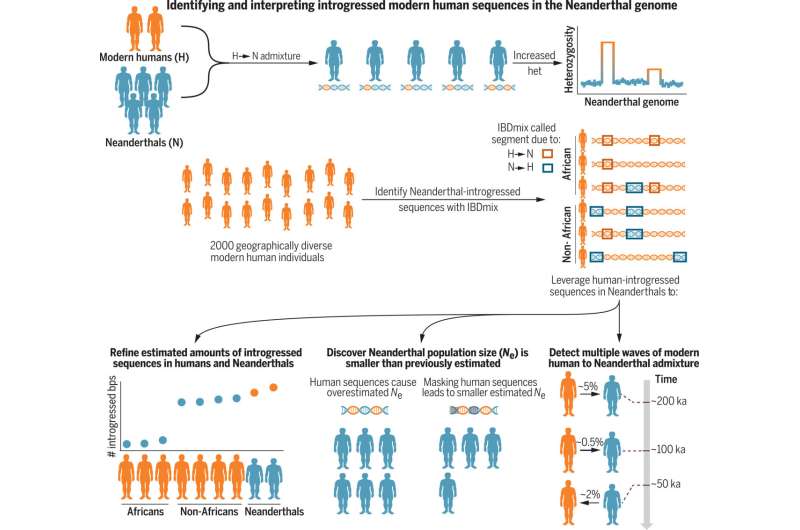"Revisiting Encounters: Geneticists Redefine the Story of Neanderthals and Ancient Humans"

July 11, 2024
This article has been reviewed according to Science X's editorial process and policies. Editors have highlighted the following attributes while ensuring the content's credibility:
- fact-checked
- peer-reviewed publication
- trusted source
- proofread
by Princeton University
Ever since the first Neanderthal bones were discovered in 1856, people have wondered about these ancient hominins. How are they different from us? How much are they like us? Did our ancestors get along with them? Fight them? Love them? The recent discovery of a group called Denisovans, a Neanderthal-like group who populated Asia and South Asia, added its own set of questions.
Now, an international team of geneticists and AI experts are adding whole new chapters to our shared hominin history. Under the leadership of Joshua Akey, a professor in Princeton's Lewis-Sigler Institute for Integrative Genomics, the researchers have found a history of genetic intermingling and exchange that suggests a much more intimate connection between these early human groups than previously believed.
'This is the first time that geneticists have identified multiple waves of modern human-Neanderthal admixture,' said Liming Li, a professor in the Department of Medical Genetics and Developmental Biology at Southeast University in Nanjing, China, who performed this work as an associate research scholar in Akey's lab.
'We now know that for the vast majority of human history, we've had a history of contact between modern humans and Neanderthals,' said Akey. The hominins who are our most direct ancestors split from the Neanderthal family tree about 600,000 years ago, then evolved our modern physical characteristics about 250,000 years ago.
'From then until the Neanderthals disappeared—that is, for about 200,000 years—modern humans have been interacting with Neanderthal populations,' he said.
The results of their work appear in the current issue of the journal Science.
Neanderthals, once stereotyped as slow-moving and dim-witted, are now seen as skilled hunters and tool makers who treated each other's injuries with sophisticated techniques and were well adapted to thrive in the cold European weather.
All of these hominin groups are humans, but to avoid saying 'Neanderthal humans,' 'Denisovan humans,' and 'ancient-versions-of-our-own-kind-of-humans,' most archaeologists and anthropologists use the shorthand Neanderthals, Denisovans, and modern humans.
Using genomes from 2,000 living humans as well as three Neanderthals and one Denisovan, Akey and his team mapped the gene flow between the hominin groups over the past quarter-million years.
The researchers used a genetic tool they designed a few years ago called IBDmix, which uses machine learning techniques to decode the genome. Previous researchers depended on comparing human genomes against a 'reference population' of modern humans believed to have little or no Neanderthal or Denisovan DNA.
Akey's team has established that even those referenced groups, who live thousands of miles south of the Neanderthal caves, have trace amounts of Neanderthal DNA, probably carried south by voyagers (or their descendants).
With IBDmix, Akey's team identified a first wave of contact about 200-250,000 years ago, another wave 100-120,000 years ago, and the largest one about 50-60,000 years ago.
That contrasts sharply with previous genetic data. 'To date, most genetic data suggests that modern humans evolved in Africa 250,000 years ago, stayed put for the next 200,000 years, and then decided to disperse out of Africa 50,000 years ago and go on to people the rest of the world,' said Akey.
'Our models show that there wasn't a long period of stasis, but that shortly after modern humans arose, we've been migrating out of Africa and coming back to Africa, too,' he said. 'To me, this story is about dispersal, that modern humans have been moving around and encountering Neanderthals and Denisovans much more than we previously recognized.'
That vision of humanity on the move coincides with the archaeological and paleoanthropological research suggesting cultural and tool exchange between the hominin groups.
Li and Akey's key insight was to look for modern-human DNA in the genomes of the Neanderthals, instead of the other way around. 'The vast majority of genetic work over the last decade has really focused on how mating with Neanderthals impacted modern human phenotypes and our evolutionary history—but these questions are relevant and interesting in the reverse case, too,' said Akey.




